1993 CHEVROLET CAVALIER belt
[x] Cancel search: beltPage 43 of 308
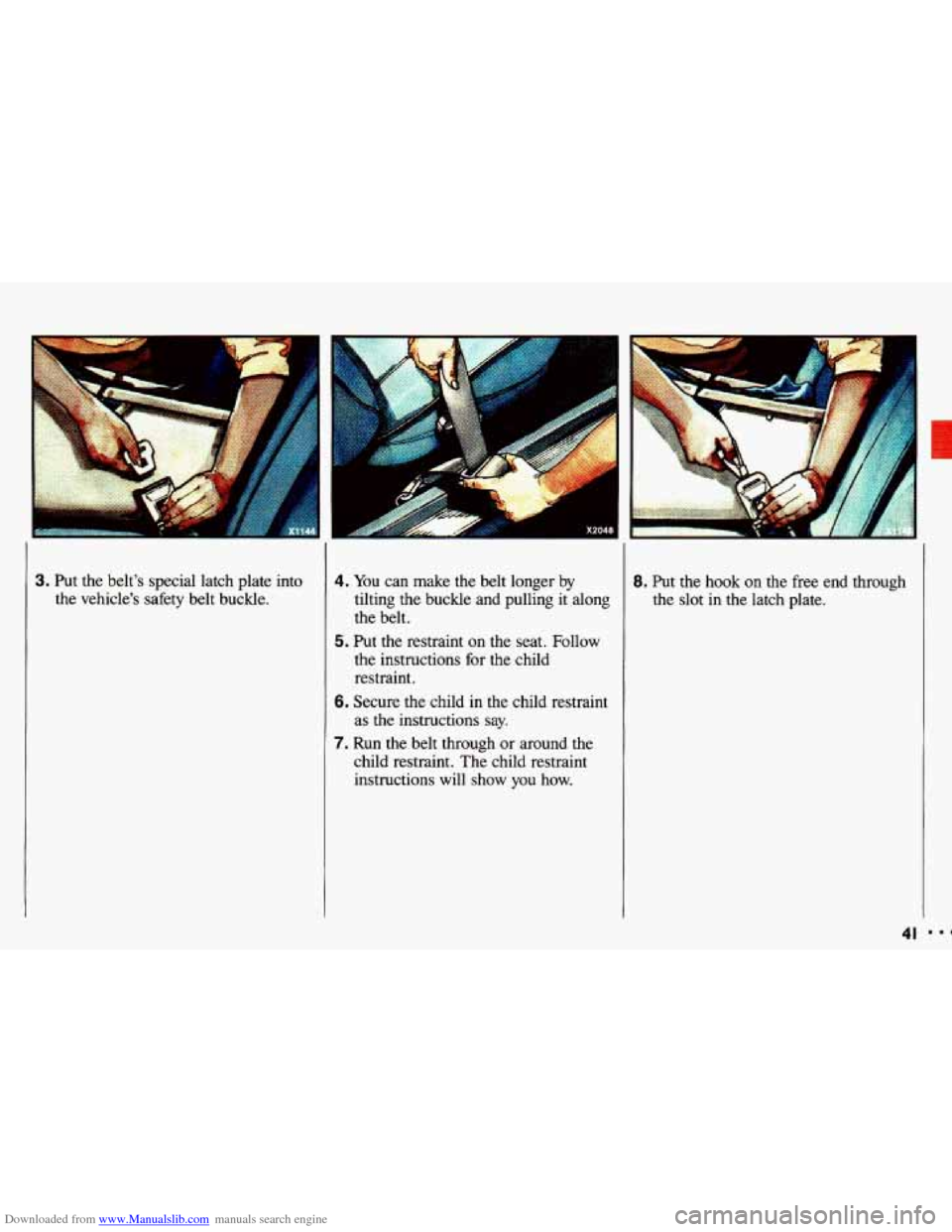
Downloaded from www.Manualslib.com manuals search engine . .. . .. ... ... . ,.. . ,.. . ....
3. Put the belt's special latch plate into
the vehicle's safety
belt buckle.
4. You can make the belt longer by
tilting the buckle and pulling it along
the belt.
the instructions for the child
restraint.
5. Put the restraint on the seat. Follow
6. Secure the child in the child restraint
as the instructions say.
7. Run the belt through or around the
child restraint. The child restraint
instructions will show
you how.
8. Put the hook on the free end through
the slot
in the latch plate.
41
Page 44 of 308
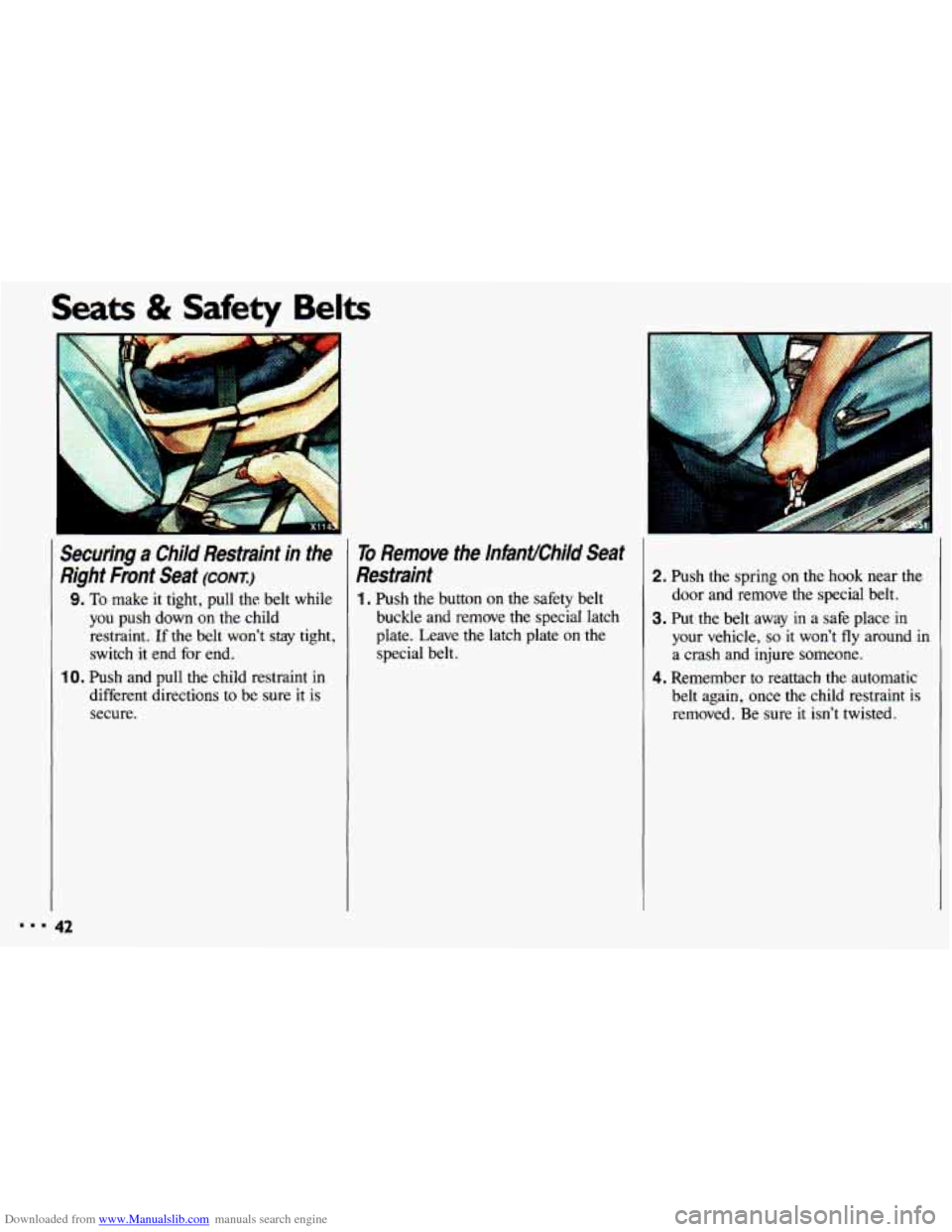
Downloaded from www.Manualslib.com manuals search engine Seats & Safety Belts
Securing a Child Restraint in the
7ight Front Seat
(CONX:)
9. To make it tight, pull the belt while
you push down on the child
restraint.
If the belt won’t stay tight,
switch
it end for end.
IO. Push and pull the child restraint in
different directions
to be sure it is
secure.
To Remove the InfanUChiId Seat
Restraint
1. Push the button on the safety belt
buckle and remove the special latch
plate. Leave the latch plate on the special belt.
2. Push the spring on the hook near the
door and remove the special belt.
3. Put the belt away in a safe place in
your vehicle, so it won’t fly around in
a crash and injure someone.
4. Remember to reattach the automatic
belt again, once the child restraint is
removed. Be sure it isn’t twisted.
Page 45 of 308
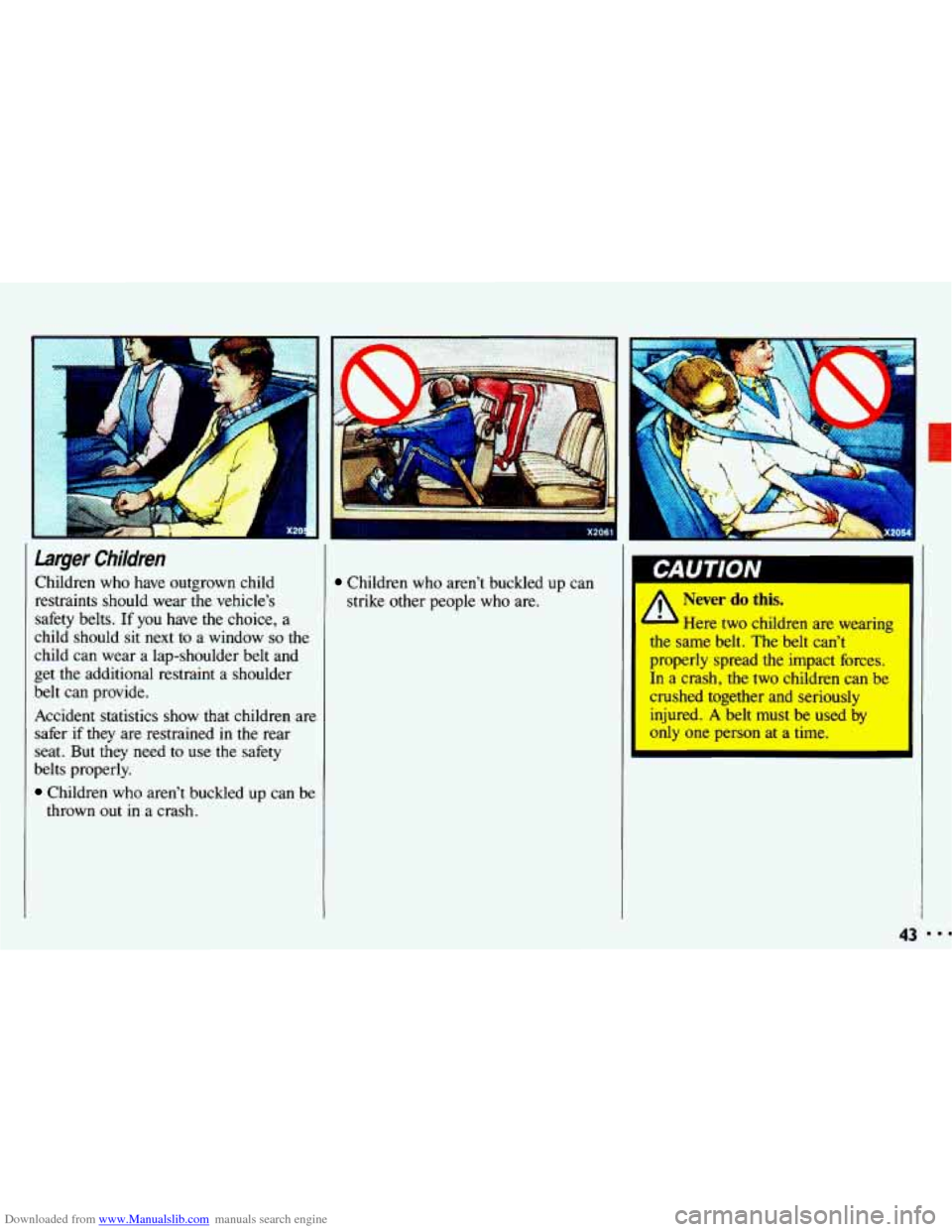
Downloaded from www.Manualslib.com manuals search engine X20
Lar,,r Children
Children who have outgrown child
restraints should wear
the vehicle's
safety belts.
If you have the choice, a
child should sit
next to a window so the
child can wear a lap-shoulder belt and
get the additional restraint a shoulder
belt can provide.
Accident statistics show that children are
safer
if they are restrained in the rear
seat. But they need
to use the safety
belts properly.
Children who aren't buckled up can be
thrown out in a crash.
x20
Children who aren't buckled up can
strike other people
who are.
L U205
11
Never do this.
Ir Here two children are wearing
the same belt. The belt can't
properly spread the impact forces.
a In a crash, the two children can be
crushed together and seriously
injured. A belt must be used by
only one person at a time.
43
Page 46 of 308
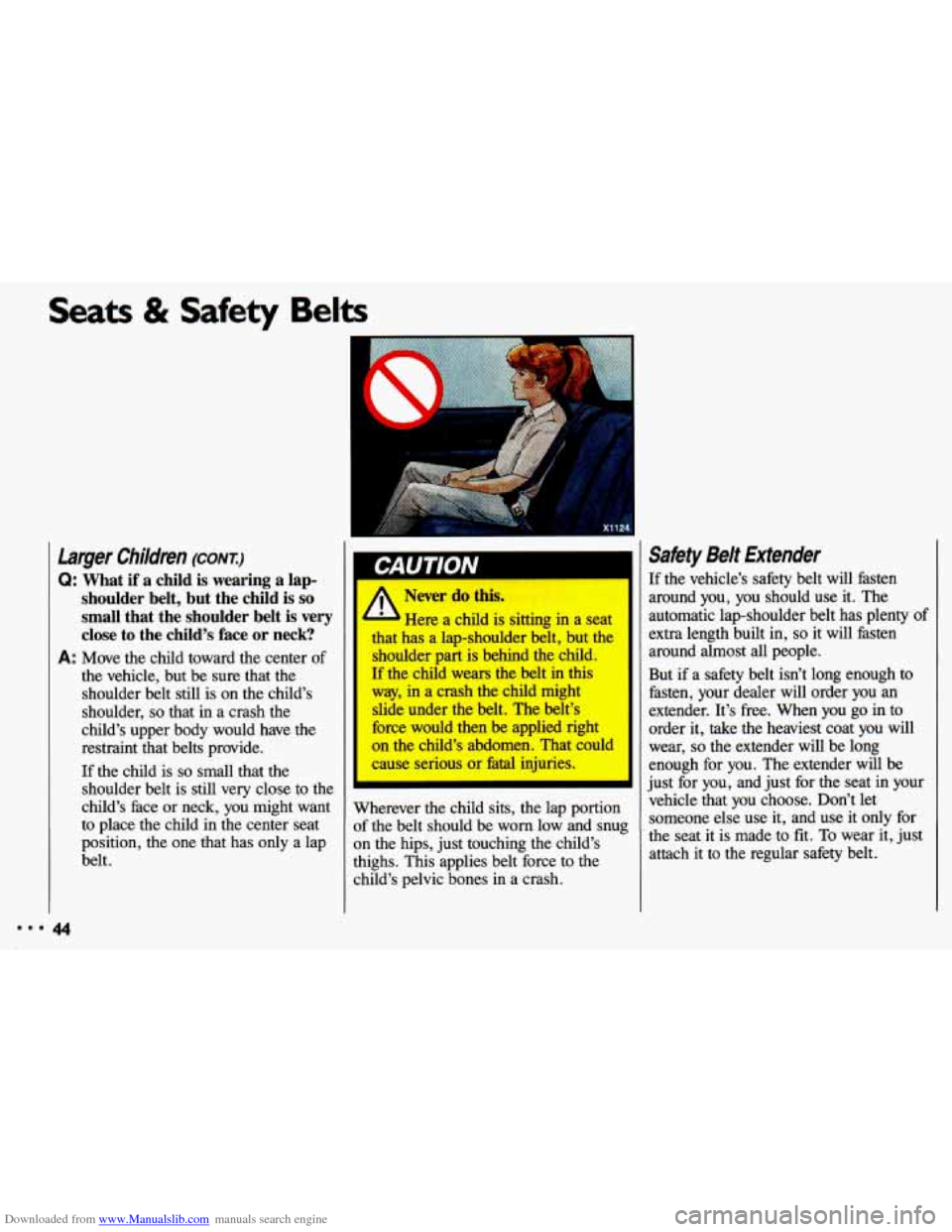
Downloaded from www.Manualslib.com manuals search engine Seats & Safety Belts
larger Children (CONT.)
Q: What if a child is wearing a lap-
shoulder belt, but the child is
so
small that the shoulder belt is very
close to the child’s face or
neck?
A: Move the child toward the center of
the vehicle, but be sure that the shoulder belt still is on the child’s
shoulder,
so that in a crash the
child‘s upper body would have the
restraint that belts provide.
If the child is
so small that the
shoulder belt is still very close to the
child’s face or neck, you might want
to place the child in the center seat
position, the one that has only a lap
belt. Here
a child is sitting in a seat
that has a lap-shoulder belt, but the
shoulder part is behind the child.
If the child wears the belt in this
way, in a crash the child might
slide under the belt. The belt’s
force would then be applied right
on the child’s abdomen. That could
cause serious or fatal injuries.
Wherever the child sits, the lap portion
of the belt should be worn low and snug
on the hips, just touching the child’s
thighs. This applies belt force to the child’s pelvic bones in a crash.
Safety Belt Extender
If the vehicle’s safety belt will fasten
around you, you should use it. The
automatic lap-shoulder belt has plenty of
extra length built in,
so it will fasten
around almost all people.
But if a safety belt isn’t long enough to
fasten, your dealer will order you
an
extender. It’s free. When you go in to
order it, take the heaviest coat you will
wear,
so the extender will be long
enough for you. The extender will be
just for you, and just for the seat in your
vehicle that you choose. Don’t let
someone else use it, and use it only for
the seat it is made to fit. To wear it, just
attach it to the regular safety belt.
Page 47 of 308
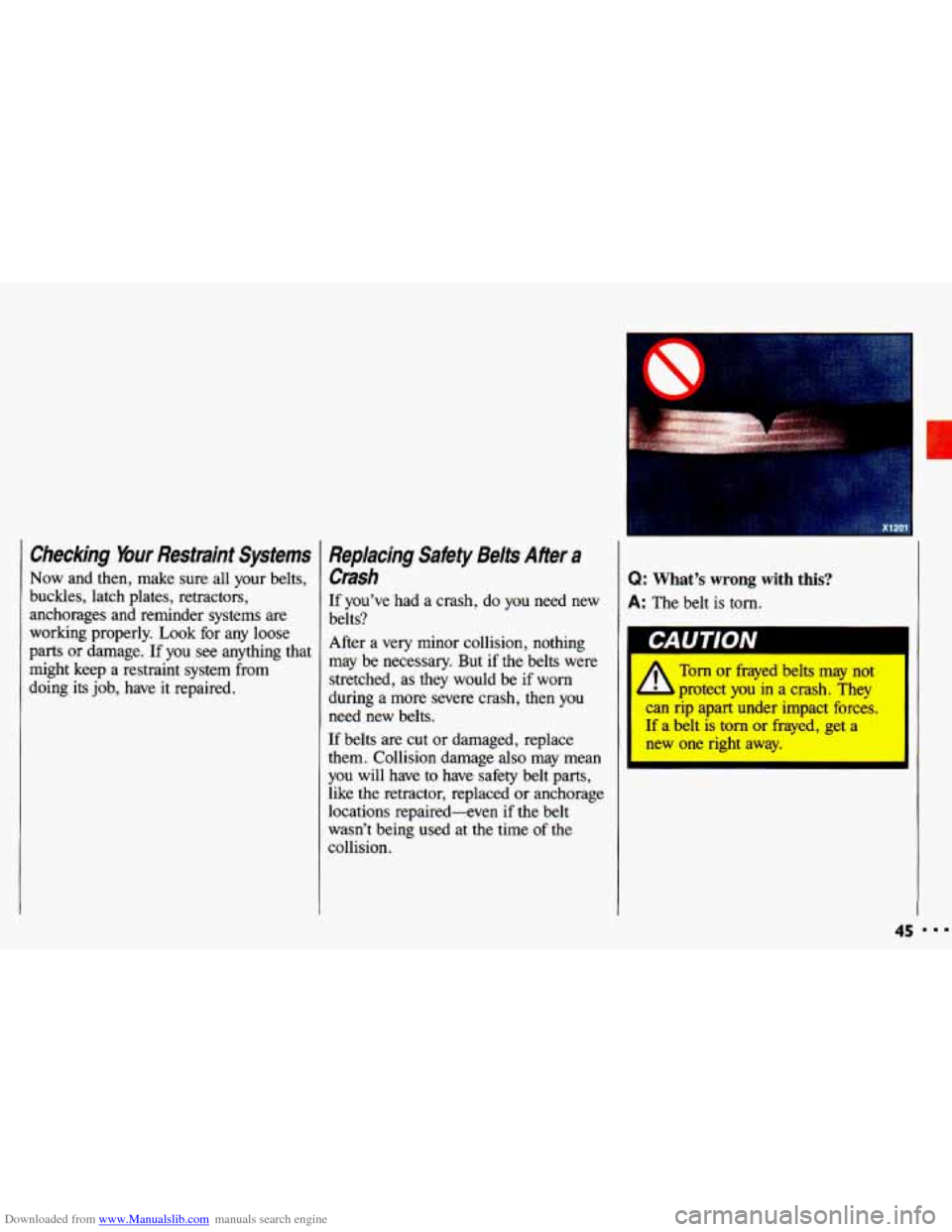
Downloaded from www.Manualslib.com manuals search engine Checking Your Restraint Systems
Now and then, make sure all your belts,
buckles, latch plates, retractors,
anchorages and reminder systems are
working properly.
Look for any loose
parts
or damage. If you see anything that
might keep a restraint system from
doing its job, have it repaired.
Replacing Safety Belts After a
Crash
If you’ve had a crash, do you need new
belts?
After a very minor collision, nothing
may be necessary. But if the belts were
stretched, as they would be if worn
during a more severe crash, then you
need new belts.
If belts are cut or damaged, replace
them. Collision damage also may mean
you will have
to have safety belt parts,
like the retractor, replaced or anchorage
locations repaired-even
if the belt
wasn’t being used at the time of the
collision.
Q: What’s wrong with this?
A: The belt is torn.
I Torn or frayed belts may not
L protect you in a crash. They
can rip apart under impact forces.
If a belt
is torn or frayed, get a
new one right away.
45
Page 51 of 308
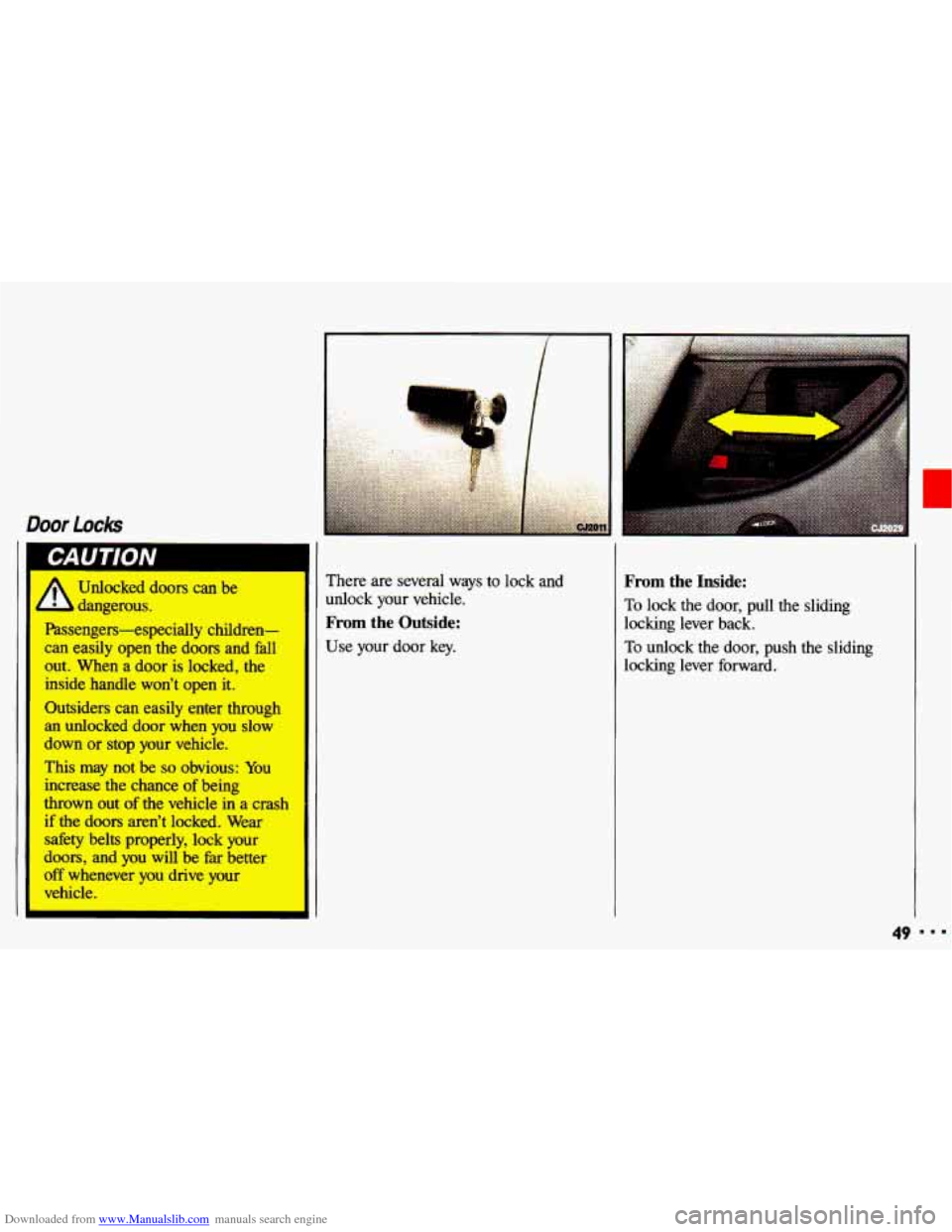
Downloaded from www.Manualslib.com manuals search engine Door Lock
A~ Unlocked doors can be
- dangerous.
Passengers-especially children-
can easily open the doors and fall
out. When
a door is locked, the
inside handle won't open it.
Outsiders can easily enter
through
an unlocked door when you slow
down or stop your vehicle.
This may not be so obvious: You
increase
the chance of being
thrown
out of the vehicle in a crash
if the doors aren't locked. Wear
dty belts properly, lock your
doors, and you will be fat better
off whenever you drive your
vehicle. There
are several ways to
lock and
unlock your vehicle.
From the Outside:
Use your door key.
From the Inside:
To lock the door, pull the sliding
locking lever back.
To unlock the door, push the sliding
locking lever forward.
49
Page 102 of 308
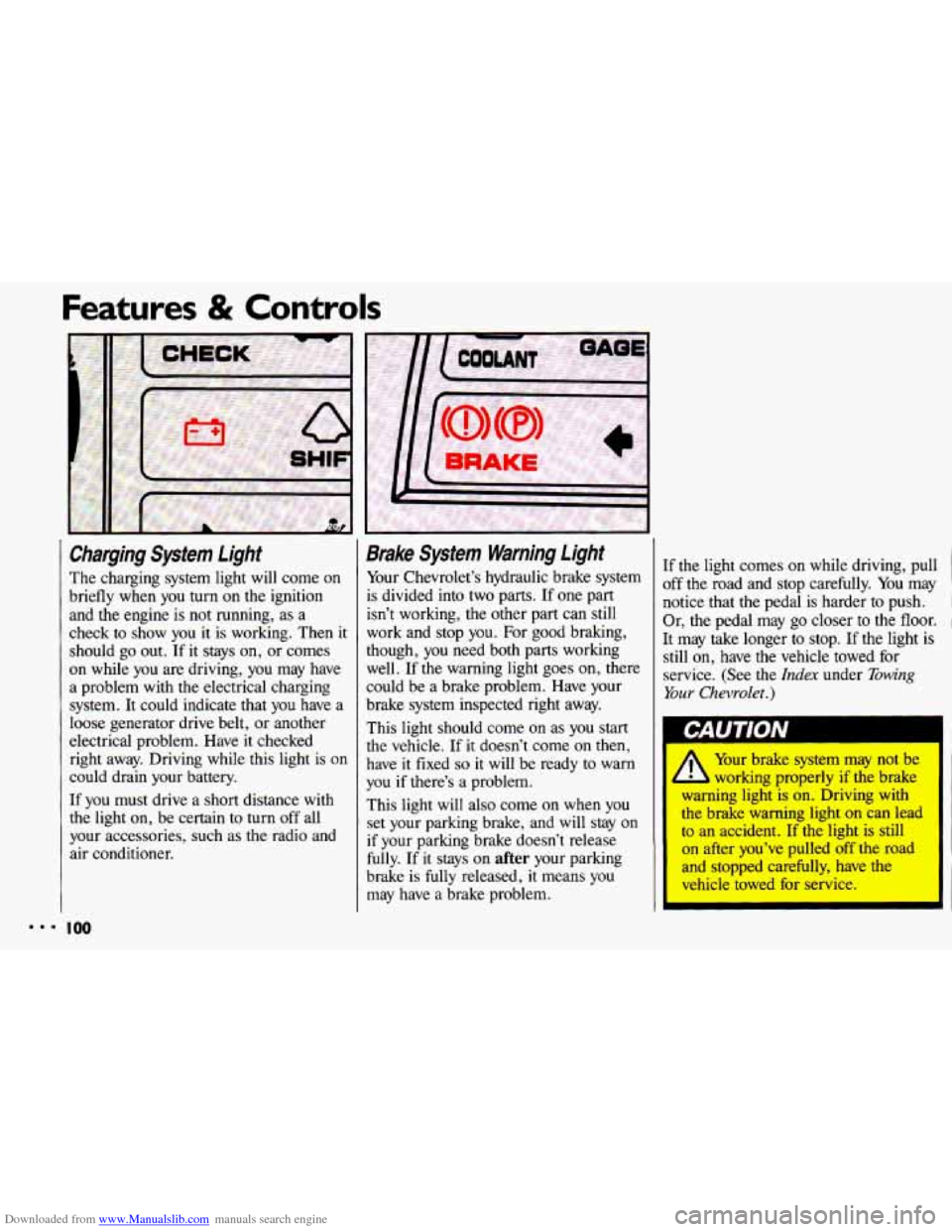
Downloaded from www.Manualslib.com manuals search engine Features & Controls
Charging System Light
The charging system light will come on
briefly when
you turn on the ignition
and the engine is not running, as a
check to show you it is working. Then it
should go out. If it stays on, or comes
on while you are driving, you may have
a problem with the electrical charging
system.
It could indicate that you have a
loose generator drive belt, or another
electrical problem. Have
it checked
right away. Driving while this light is on
could drain your battery.
If you must drive a short distance with
the light on, be certain to turn off all
your accessories, such as the radio and
air conditioner.
Brake Sysfem Warning Light
Your Chevrolet’s hydraulic brake system
is divided into two parts. If one part
isn’t working, the other part can still
work and stop you. For good braking,
though, you need both parts working
well. If the warning light goes on, there
could be a brake problem. Have your
brake system inspected right away.
This light should come on as you start
the vehicle. If it doesn’t come on then,
have
it fixed so it will be ready to warn
you if there’s
a problem.
This light will also come on when you
set your parking brake, and will stay
on
if your parking brake doesn’t release
fully. If it stays
on after your parking
brake is fully released,
it means you
may have
a brake problem. If
the light comes
on while driving, pull
off the road and stop carefully. You may
notice that the pedal is harder to push.
I
Or, the pedal may go closer to the floor. 1
It may take longer to stop. If the light is
still on, have the vehicle towed for
service. (See the
Index under Towing
Your Chevrolet.)
L-AU I IVN
I
/1 Your brake system may not be
L working properly if the brake
warning light is on. Driving with
the brake warning light
on can lead
to an accident. If the light is still
on after you’ve pulled off the road
and stopped carefully, have the
vehicle towed for service.
I
Page 130 of 308
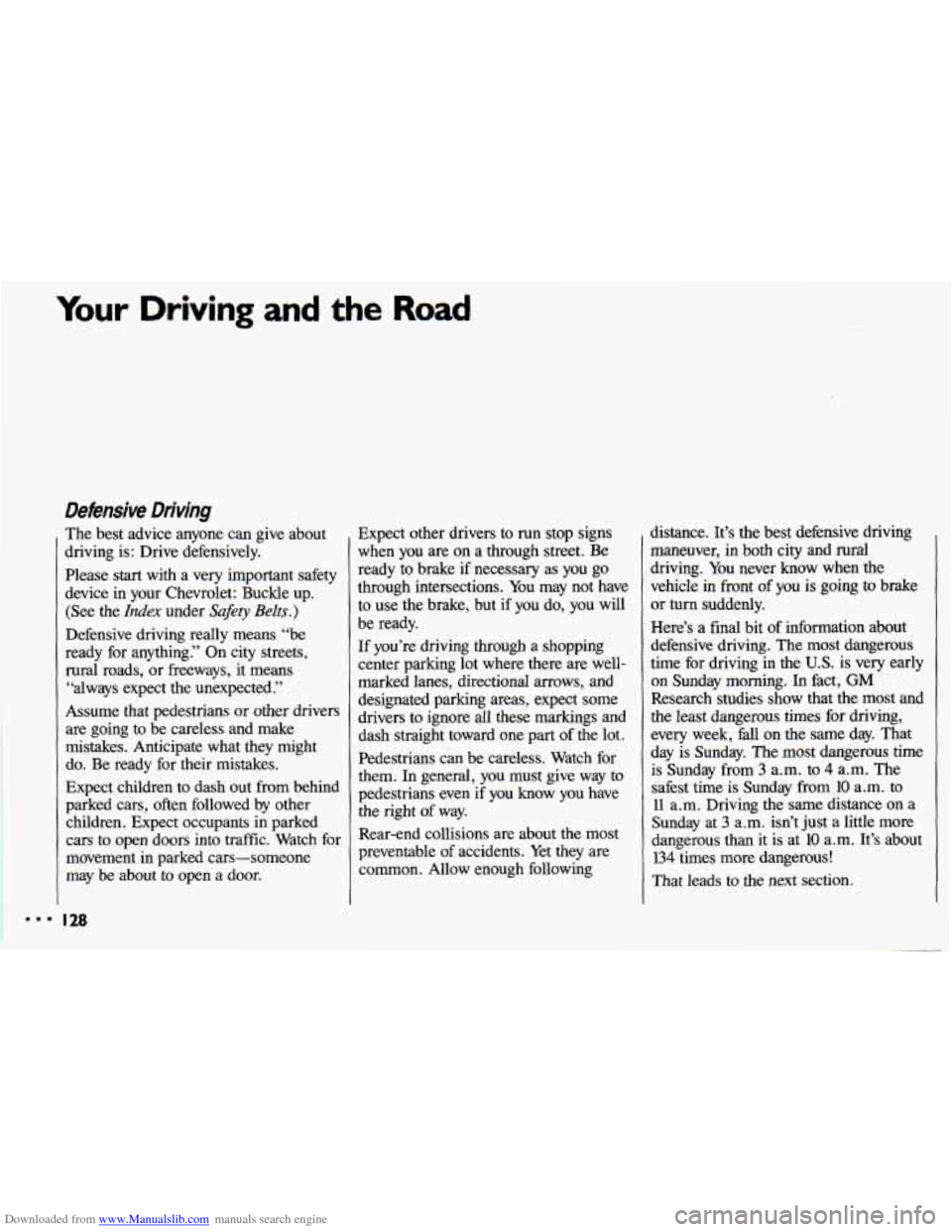
Downloaded from www.Manualslib.com manuals search engine Your Driving and the Road
Defensive Driving
The best advice anyone can give about
driving is: Drive defensively.
Please
start with a very important safety
device in your Chevrolet: Buckle up. (See the
Index under Safety Belts.)
Defensive driving really means “be
ready for anything.” On city streets, rural roads, or freeways, it means
“always expect the unexpected.”
Assume that pedestrians or other drivers
are going to be careless and make
mistakes. Anticipate what they might do. Be ready for their mistakes.
Expect children to dash out from behind
parked cars, often followed by other
children. Expect occupants in parked
cars to open doors into traffic. Watch for movement in parked cars-someone
may be about to open a door.
213
Expect other drivers to run stop signs
when you are on a through street. Be
ready to brake if necessary as you go
through intersections. You may not have
to use the brake, but if you do, you will
be ready.
If you’re driving through a shopping
center parking lot where there are well-
marked lanes, directional arrows, and
designated parking areas, expect some
drivers to ignore
all these markings and
dash straight toward one part of the lot.
Pedestrians can be careless. Watch for
them.
In general, you must give way to
pedestrians even if you know you have
the right of way.
Rear-end collisions are about the most
preventable of accidents. Yet they are
common. Allow enough following distance. It’s the best defensive driving
maneuver, in both city and
rural
driving.
You never know when the
vehicle in front of you is going
to brake
or turn suddenly.
Here’s a final bit
of information about
defensive driving. The most dangerous
time for driving in the
U.S. is very early
on Sunday morning.
In fact, GM
Research studies show that the most and
the least dangerous times for driving,
every week, fall on the same day. That
day is Sunday. The most dangerous time
is Sunday from
3 a.m. to 4 a.m. The
safest time is Sunday from
10 a.m. to
11 a.m. Driving the same distance on a
Sunday at
3 a.m. isn’t just a little more
dangerous than it is at
10 a.m. It’s about
134 times more dangerous!
That leads to the next section.